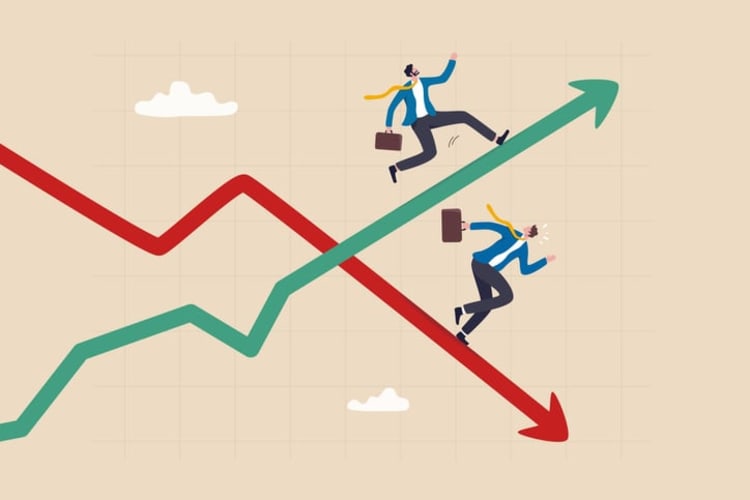The Great Resignation has become a buzzword in recent times, as millions of workers across the globe are leaving their jobs in search of something better. But what lies beneath this phenomenon? Why are so many people suddenly resigning, and how are businesses adapting to these changes? In this blog post, we’ll explore the driving forces behind the Great Resignation, its impact on various industries, and the strategies employers can use to retain talent during these turbulent times. Let’s dive in and uncover the secrets of this massive workforce shift.
Key takeaways
- The Great Resignation Phenomenon refers to the collective trend of millions of employees leaving their jobs due to a variety of factors, most notably the COVID-19 pandemic.
- Factors fueling The Great Resignation include employee dissatisfaction and a desire for better work-life balance.
- Companies have adapted by deploying strategies such as improving workplace culture, investing in diversity & inclusion initiatives, and offering training & mentorship opportunities.
The Great Resignation phenomenon

The Great Resignation Phenomenon refers to the mass exodus of employees from their jobs, driven by various factors such as the COVID-19 pandemic, work-life balance issues, and job dissatisfaction. According to the U.S. Bureau of Labor Statistics, between April 2021 and April 2022, an astounding 71.6 million people separated from their jobs, averaging 3.98 million people quitting each month. In November 2021 alone, 4.5 million Americans quit their jobs, showcasing the magnitude of this ongoing trend involving workers quitting.
The term “Great Resignation” was coined by associate professor Anthony Klotz, who has been featured in the Harvard Business Review for his insights on this phenomenon. Klotz identified five factors contributing to the Great Resignation:
- Retirement
- Relocation
- Reconsideration
- Reshuffling
- Reluctance, with some employees seeking higher pay.
The pandemic has played a significant role in driving these factors, as people reevaluate their priorities and seek jobs that better align with their values and needs, a trend also observed by the Pew Research Center.
Older workers, in particular, have been influenced by the Great Resignation, with factors such as rising stock markets, increasing residential property values, and heightened risk of serious health issues driving them to leave the workforce. However, the influence of the Great Resignation extends beyond specific age groups or industries, impacting both blue-collar and white-collar sectors with substantial workforce disruptions.
Factors fueling the Great Resignation

Understanding the Great Resignation requires a thorough examination of the factors driving this trend. The subsequent subsections detail:
- The pandemic’s effect on work
- The growing aspiration for improved work-life balance
- The part played by job dissatisfaction in employees’ decisions to resign.
Pandemic impact
The COVID-19 pandemic has undoubtedly left an indelible mark on the world of work. As businesses and employees grappled with the challenges brought on by the pandemic, many individuals faced burnout, delayed decisions, and a reevaluation of their work priorities. These factors have led to an unprecedented number of people quitting their jobs voluntarily, causing a tight labor market in 2021.
The pandemic also elevated the importance of job satisfaction and employee development, leading to a wider adoption of a reconfigured relationship with work. As people looked for more meaningful and fulfilling work experiences, the pandemic’s impact on the Great Resignation became increasingly evident, driving employees to seek better opportunities that align with their values and needs.
Work-life balance
A crucial factor driving the Great Resignation is the quest for a better work-life balance. The pandemic highlighted the importance of maintaining a healthy equilibrium between work and personal life, as people realized the need for flexibility and fulfillment in their jobs. The benefits of better work-life balance include enhanced productivity, improved mental well-being, and increased job satisfaction, which are vital for industries like accommodation and food services.
During the Great Resignation, employees have prioritized work-life balance above other benefits. In fact, the most sought-after benefits include a flexible schedule and hybrid or remote work opportunities. As a result, employers must adapt to these changing priorities to attract and retain top talent amidst the ongoing workforce exodus.
Job dissatisfaction

Another major contributor to the Great Resignation is job dissatisfaction. Common causes of dissatisfaction include:
- Wage stagnation
- Limited prospects for career progression
- Hostile work environments
- Inadequate benefits
- Inflexible remote-work policies
- Long-term job dissatisfaction
As employees grow increasingly discontent with their current positions, they are more likely to seek new opportunities that promise higher pay, better working conditions, and more advancement opportunities.
The Great Resignation is, in essence, a response to widespread job dissatisfaction. Employees are no longer willing to settle for subpar working conditions and are instead pursuing positions that offer greater fulfillment, satisfaction, and alignment with their personal values and needs. This trend has significantly impacted the labor market, leading to a massive shift in workforce dynamics and priorities.
The Great Resignation's effect on different industries

The Great Resignation has had varying effects on different industries, with some being hit harder than others. Industries such as hospitality, retail, and healthcare have experienced significant labor shortages, forcing businesses to adapt their strategies to attract and retain talent. On the other hand, industries like professional and business services have been less impacted, as they have been better positioned to offer flexible work arrangements and attractive benefits packages.
Other industries, such as nondurable goods, retail trade, and small businesses, have also been heavily affected by the Great Resignation. These sectors have faced considerable labor shortages, leading to increased turnover and the need for new hires. Blue-collar and white-collar sectors, including:
- Apparel retail
- Manufacturing
- Technology
- Healthcare
Many industries, including the federal reserve bank, have likewise experienced significant labor force disruptions, impacting frontline workers and the labor force participation rate.
While the effects of the Great Resignation can vary across industries, it’s clear that each industry must adapt and innovate in order to survive and thrive in this new labor market landscape. By understanding the specific challenges and opportunities facing each sector, businesses can develop targeted strategies to navigate the complexities of the Great Resignation and maintain a competitive edge.
Navigating the job market during the Great Resignation

With the Great Resignation persistently altering the labor market, it necessitates adaptability from both job seekers and employers. For job seekers, this translates into placing higher importance on purpose, meaning, and company values during their pursuit of new opportunities. In a job market marked by high turnover and fierce competition for top talent, it’s imperative for job seekers to approach their search with discernment and strategy.
For employers, the Great Resignation brings forth a mix of new challenges and opportunities. Companies striving to attract and retain talent should concentrate on:
- Streamlining recruitment processes
- Endorsing diversity initiatives
- Leveraging different talent pools
- Prioritizing finding the right fit over background
- Investing in diversity and inclusion programs to create a more inclusive and supportive workplace culture.
Moreover, companies should be proactive in addressing potential diversity hiring mistakes, as research indicates that approximately 49% of job seekers inquire about diversity and inclusion initiatives within a company. By staying ahead of the curve and embracing change, employers can successfully navigate the job market during the Great Resignation and build a resilient workforce for the future.
Strategies for employers to retain talent
In response to the Great Resignation, it’s imperative for employers to devise and execute robust strategies for talent retention. The subsequent subsections illustrate how companies can accomplish this through competitive compensation and benefits, cultivating a positive workplace culture, and offering avenues for growth and development.
Compensation and benefits
A key factor in employee retention is the provision of attractive compensation packages and benefits. Offering competitive remuneration and meaningful benefits can help draw and retain top talent, ensuring retention and reducing the cost of replacing employees. Industries with the highest attrition rates, such as hospitality and retail, have responded by significantly increasing wages in an effort to replenish their workforce.
One notable example is McDonald’s, which increased hourly wages for existing staff members by an average of 10% and raised entry-level wages to between $11 and $17 an hour. The company took their employee benefits to the next level. They now offer emergency childcare, paid time off and tuition reimbursement. This demonstrates the power of competitive compensation and benefits in retaining talent during the Great Resignation.
Workplace culture
A supportive and inclusive workplace culture is essential for employee retention. Research has shown that a negative culture can be a primary factor in employees deciding to leave their jobs. Conversely, a positive and nurturing culture can:
- Increase employee happiness
- Increase employee commitment
- Increase employee loyalty
- Result in higher retention rates
Employers looking to prevent employee departures during the Great Resignation should prioritize creating a supportive and inclusive workplace culture that promotes employee satisfaction, engagement, and loyalty. This includes investing in diversity and inclusion programs, fostering open communication, and providing employees with the resources and support they need to thrive.
Employee development and growth
Providing opportunities for skill development and career advancement is another crucial strategy for retaining talent during the Great Resignation. By offering training programs, mentorship opportunities, and career advancement options, employers can foster a more engaged and motivated workforce, leading to higher retention rates.
A prime example of a company investing in employee development is Walmart, with their Live Better U program. This $1 billion initiative covers 100% of college tuition and book costs for the company’s associates over the next five years. By prioritizing employee growth and development, companies like Walmart are better equipped to retain talent and navigate the challenges of the Great Resignation.
The future of the labor market: beyond the Great Resignation

As stability returns to the labor market, emergent trends like the “Big Stay” and the “Great Rehire” are molding the future of work. A recent labor turnover survey shows that the rate of Americans quitting their jobs has decreased by 5% in the first quarter of 2023 compared to the last quarter of 2022, indicating a potential shift in the labor market dynamics. The Great Rehire, on the other hand, refers to the initiative to address the vacancies created by the Great Resignation.
With 11.4 million job openings in the U.S. as of April 2022, the job market remains competitive and dynamic. The discourse surrounding the “Big Stay” involves debates over the duration of the phenomenon and the likelihood of the job market’s recovery. As businesses and employees traverse these new trends, adaptability and forward-thinking become crucial for thriving in the ever-evolving labor market landscape
Case studies: companies adapting to the Great Resignation
Numerous companies have adeptly responded to the Great Resignation by deploying employee retention strategies and welcoming change. These businesses provide valuable case studies for other organizations aiming to tackle the challenges of the Great Resignation while sustaining a competitive edge in the labor market.
Kumospace, a virtual office platform, stands out as a prime example of a company adapting to the Great Resignation. Recognizing the shift towards remote work, Kumospace innovated by creating a more interactive and engaging online environment for employees. Their platform simulates a physical office, allowing workers to move around virtual rooms and interact spontaneously, thereby nurturing a sense of community and collaboration often missing in traditional remote work setups.
This approach not only helps in retaining current employees by offering a unique and inclusive work experience but also attracts new talent who value flexibility and innovation. Kumospace's commitment to enhancing remote work culture aligns with the evolving expectations of the workforce, positioning them as a forward-thinking player in employee engagement and retention strategies.
Summary
The Great Resignation has undoubtedly transformed the labor market, driven by factors such as the pandemic, work-life balance, and job dissatisfaction. As industries grapple with the effects of this workforce exodus, both job seekers and employers must adapt to the changing landscape. By prioritizing purpose, meaning, and company values, job seekers can find fulfilling opportunities in this competitive market, while employers can retain top talent by offering competitive compensation, fostering positive workplace culture, and providing opportunities for growth and development. As we move beyond the Great Resignation, it’s crucial for businesses and employees to continue embracing change and innovation to shape the future of work.
Frequently asked questions
The Great Resignation appears to be over, and US workers are no longer voluntarily leaving their jobs at elevated rates. It seems unlikely that it will continue into 2023.
The primary cause of the Great Resignation is likely intense competition for workers, as reflected in a high number of job vacancies and a lower unemployment rate. Other factors such as wage stagnation, limited career advancement opportunities, hostile work environments, lack of benefits, inflexible remote-work policies, and job dissatisfaction have also contributed to this "record-breaking departure from jobs in a shockingly small window of time."
The Great Resignation was an unprecedented phenomenon that has since slowed down and been replaced by a less defined trend. Now, experts agree that the trend is finished, with the rate of people quitting their jobs having fallen to pre-pandemic levels. Overall, it seems the Great Resignation is no longer relevant.
The Great Resignation is a term coined by Anthony Klotz to refer to the large number of people who left their jobs due to unhappiness with work environments, industries, or work-life balance, compounded by the rise of remote work and increasing stress levels made worse by the pandemic.
The pandemic's effect on employment, the desire for a better work-life balance, and dissatisfaction with job conditions are all contributing to the Great Resignation.





